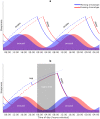The effect of chronotype on sleepiness, fatigue, and psychomotor vigilance of ICU nurses during the night shift
- PMID: 25672276
- PMCID: PMC4392115
- DOI: 10.1007/s00134-015-3667-7
The effect of chronotype on sleepiness, fatigue, and psychomotor vigilance of ICU nurses during the night shift
Abstract
Purpose: In general, sleeping and activity patterns vary between individuals. This attribute, known as chronotype, may affect night shift performance. In the intensive care unit (ICR), night shift performance may impact patient safety. We have investigated the effect of chronotype and social demographics on sleepiness, fatigue, and night shift on the performance of nurses.
Methods: This was a prospective observational cohort study which assessed the performance of 96 ICU night shift nurses during the day and night shifts in a mixed medical-surgical ICU in the Netherlands. We determined chronotype and assessed sleeping behaviour for each nurse prior to starting shift work and before free days. The level of sleepiness and fatigue of nurses during the day and night shifts was determined, as was the effect of these conditions on psychomotor vigilance and mathematical problem-solving.
Results: The majority of ICU nurses had a preference for early activity (morning chronotype). Compared to their counterparts (i.e. evening chronotypes), they were more likely to nap before commencing night shifts and more likely to have young children living at home. Despite increased sleepiness and fatigue during night shifts, no effect on psychomotor vigilance was observed during night shifts. Problem-solving accuracy remained high during night shifts, at the cost of productivity.
Conclusions: Most of the ICU night shift nurses assessed here appeared to have adapted well to night shift work, despite the high percentage of morning chronotypes, possibly due to their 8-h shift duration. Parental responsibilities may, however, influence shift work tolerance.
Figures


Comment in
-
Chronotypes, night shifts and intensive care.Intensive Care Med. 2015 Apr;41(4):698-700. doi: 10.1007/s00134-015-3711-7. Epub 2015 Mar 3. Intensive Care Med. 2015. PMID: 25731637 No abstract available.
Similar articles
-
Who is sleepier on the night shift? The influence of bio-psycho-social factors on subjective sleepiness of female nurses during the night shift.Ergonomics. 2018 Jul;61(7):1004-1014. doi: 10.1080/00140139.2017.1418027. Epub 2017 Dec 23. Ergonomics. 2018. PMID: 29239697
-
Performance and sleepiness in nurses working 12-h day shifts or night shifts in a community hospital.Accid Anal Prev. 2019 May;126:43-46. doi: 10.1016/j.aap.2017.09.023. Epub 2017 Oct 5. Accid Anal Prev. 2019. PMID: 28987265
-
Sleepiness in Spanish nursing staff--influence of chronotype and care unit in circadian rhythm impairment: research protocol.J Adv Nurs. 2014 Jan;70(1):211-9. doi: 10.1111/jan.12200. Epub 2013 Jul 3. J Adv Nurs. 2014. PMID: 23834526
-
Impacts of shift work on sleep and circadian rhythms.Pathol Biol (Paris). 2014 Oct;62(5):292-301. doi: 10.1016/j.patbio.2014.08.001. Epub 2014 Sep 20. Pathol Biol (Paris). 2014. PMID: 25246026 Review.
-
Napping on night-shifts among nursing staff: A mixed-methods systematic review.J Adv Nurs. 2019 Feb;75(2):291-312. doi: 10.1111/jan.13859. Epub 2018 Nov 12. J Adv Nurs. 2019. PMID: 30229998
Cited by
-
Associating night-shift work with lifetime use of sleep medication and sleep quality in a cohort of female nurses.Ann Work Expo Health. 2023 Nov 28;67(9):1056-1068. doi: 10.1093/annweh/wxad058. Ann Work Expo Health. 2023. PMID: 37758464 Free PMC article.
-
Sleepiness and injury risk in emergency medical service workers in Taiwan.PLoS One. 2020 Feb 24;15(2):e0229202. doi: 10.1371/journal.pone.0229202. eCollection 2020. PLoS One. 2020. PMID: 32092086 Free PMC article.
-
Shift rotation, circadian misalignment and excessive body weight influence psychomotor performance: a prospective and observational study under real life conditions.Sci Rep. 2019 Dec 18;9(1):19333. doi: 10.1038/s41598-019-55114-w. Sci Rep. 2019. PMID: 31852906 Free PMC article.
-
Determinants of Sleep Disorders and Occupational Burnout among Nurses: A Cross-Sectional Study.Int J Environ Res Public Health. 2022 May 20;19(10):6218. doi: 10.3390/ijerph19106218. Int J Environ Res Public Health. 2022. PMID: 35627754 Free PMC article.
-
Characteristics of nursing professionals and the practice of ecologically sustainable actions in the medication processes.Rev Lat Am Enfermagem. 2017 Jun 8;25:e2909. doi: 10.1590/1518-8345.1516.2909. Rev Lat Am Enfermagem. 2017. PMID: 28614432 Free PMC article.
References
Publication types
MeSH terms
LinkOut - more resources
Full Text Sources
Other Literature Sources
Medical
Research Materials

